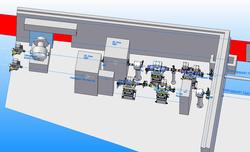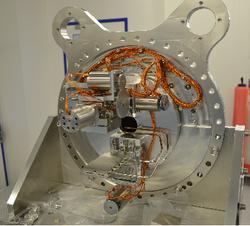11 period undulator in the test facility
The beamline has four different parts:
(1) The period of the undulator was determined by the requested large overlap of the first and third harmonic in order to avoid changes in the harmonic or an intensity variation of more than a factor of 5 over the range of an EXAFS-scan.
(2) The filter unit of P65 has four different filters: glassy carbon with thicknesses of 0.4, twice 1mm in different units, and 4mm.
The slit-system consists of three different pairs of slits: 2 vertical and 1 horizontal pairs. The first vertical pair has a minimum opening of 1mm, the other two pairs can be completely closed.
(3) The optics hutch is the first enclosure in the experimental hall. Two plane mirrors with three different coatings each reduce higher harmonic radiation. The first mirror is water-cooled. The water cooled C-type DCM is installed behind the mirrors to reduce the power load on the first crystal.
(4) The experimental hutch is the place, where the user experiments are performed. The sample can be a simple metal foil or pellet or a complex system in a specialized sample-environment like a furnace with different gas-inlets, a mass-spectrometer for measurements of reaction-output, and a fluorescence detector in order to measure low-concentration samples.
The standard set-up consists of 3 ionisation chambers for transmission measurements and an optional 7 pixel fluorescence detector. Users can install their own sample cells for in-situ measurements etc. on the experimental table.







